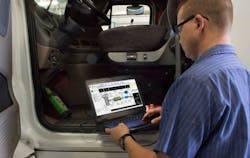Ask the Expert: What do you look for when selecting a heavy duty diagnostic tool?
Q: What do you look for when selecting a heavy duty diagnostic tool?
A: First of all, I look for a tool that assists in the repair process as well as the diagnosis process. I want extensive bi-directional testing capabilities and any OEM guides or troubleshooting information to speed up the repair process. In addition, the best tools have very few glitches, hook up fast and have most features available from one or two screens.
The right tool will be set up like a well-organized mechanic’s toolbox. Fault information is the wrench and socket drawer; we need them first and often without the requirement of opening multiple drawers. Other tools are not used as often but should never be hidden or hard-to-find; tools quit making a mechanic money as soon as he or she cannot locate it. Too often I see techs not use a function in a specific software simply because that feature is too hard to find; I stay away from this type of tool.
When selecting a tool, I place a lot of importance on reliable, accurate information within the software. Certain tools have glitches, such as certain sensors reading incorrect numbers due to the sensor not being online until a future emissions update. So if I can’t consistently trust the accuracy of it, I will not consider that tool.
I work on a variety of makes, models and components, so I require consistency across the look and feel of the software. I have used tools in the past where, for example, hooking up to a Peterbilt is completely different than hooking up to a Freightliner and that makes the training process lengthy and confusing. I want a familiar screen and layout regardless of which OEM manufactured the vehicle I am hooking up to.
Finally, I search for a tool I can trust for a long time. The best tool will be a single solution, where one piece of software allows me to work on vehicles, regardless of the make, model and components involved. Coverage needs to be constantly updated and features often added so I can continue to work on the newest vehicles with the latest tests available in the industry.
Information provided by: Sean Roland, vehicle data specialist, Noregon Systems
